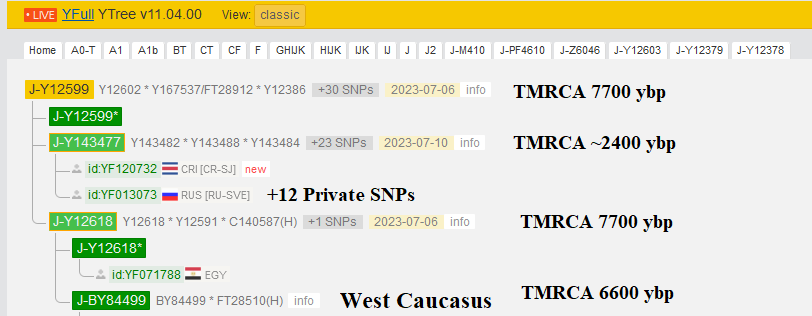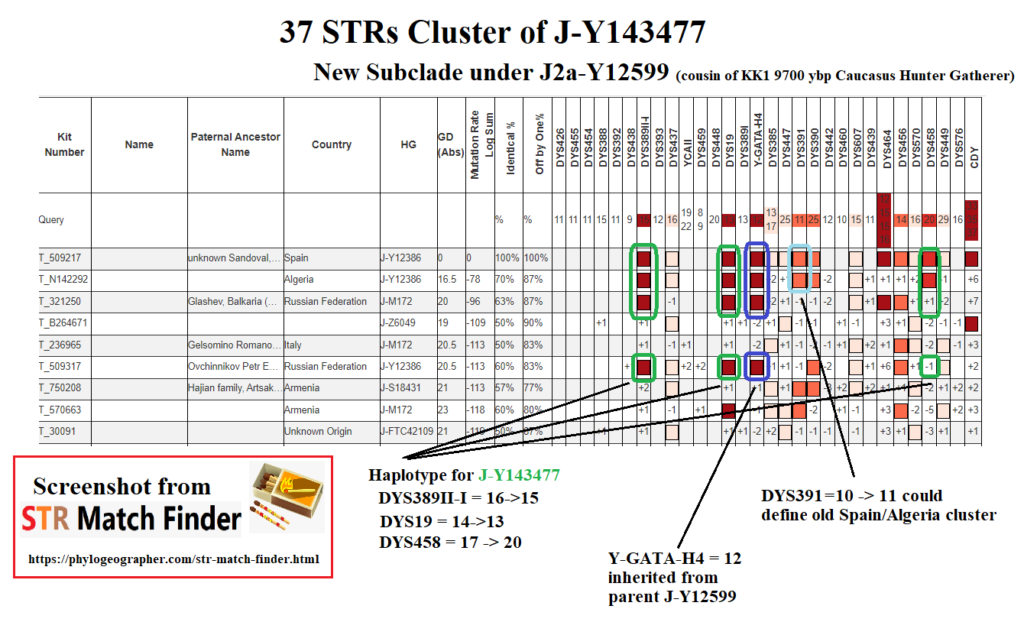In July, the live version of YFull v11.03 showed that a new Nebula WGS sample tracing descent to San Jose, Costa Rica and a Big Y-500 sample tracing descent to Sverdlovsk, Russia formed a new branch below J2a-Y12599. The new branch J2a-Y143477 consists of 26 SNPs and should be visible on the official tree for v11.05. I used interpolation to estimate 2400 ybp for the TMRCA of the new branch.
This line may have been in the Caucasus for the last 10,000 years because its cousin KK1 was a Caucasus Hunter Gatherer who lived 9700 years ago in the Kotias Klde Cave in Imereti, Georgia not far from where I live and which I visited in 2019 (Photos of me!).

Using STR Match Finder and entering in samples from public J2 and Russia projects, I found a cluster of men with a divergent STR haplotype including the sample who I believe to be the Big Y-500 sample from Sverdlovsk.

The four men in the J2a-Y143477 cluster have only tested up to 37 STRs. The Big Y must have been ordered back when it only included 37 STRs. This makes sense given his very low YFull id, an indicator that he submitted his sample several years ago.
The men trace their male line ancestors to Spain, Algeria, Balkaria and Sverdlovsk.
| STR | Haplogroup | Allele | Mutation Rate (years) |
| DYS389ii-i | J2a-Y12599 | 16 | 10788 |
| DYS19 | J2a-Y12599 | 14 | 17783 |
| DYS458 | J2a-Y12599 | 17 | 6129 |
| DYS389ii-i | J2a-Y143477 | 15 | 6278 |
| DYS19 | J2a-Y143477 | 13 | 18001 |
| DYS458 | J2a-Y143477 | 20 | < 3000? |
Spain and Algeria samples may form subcluster
I think there is a chance that the two men from Spain and Algeria may descend from a more recent common ancestor based on both having DYS391 = 10 -> 11 that the other men lack.
They being the only two samples of the cluster to have DYS458 = 20 may be due to conservation of the allele from the J-Y143477 MRCA given that the other two samples have 21 and 19. I don’t have statistics computed for the mutation rate of DYS458 = 20 allele due to low sample size, but the mutation rate for DYS458 = 19 was over three times faster than for DYS458 = 18. If the mutation rate for DYS458 = 20 is 2000-3000 years, then we would expect to see around two of four samples descending from a ~2400 ybp TMRCA to have deviated from the haplotype.
Migration from the Caucasus in 400 BCE that eventually went to Spain and Algeria
The geography of the two samples from Spain and Algeria are interesting because they are so far from the likely origin of the Caucasus.
The Sauromatians were allegedly an ancient Scythian people living north of the Caucasus between the 6th and 4th centuries BCE. According to Wikipedia:Sauromatians#Demise, these people were conquered by invaders from the east, and while they no longer formed the majority of the resulting population, they still lent their name in the form of “Sarmatians” to the group of tribes which would later emerge: Aorsi, Roxolani, Alans and Iazyges.
Of these constituent tribes, the Alans are known from the historic record to have invaded Iberia as part of an alliance with the Vandals and the Suebi. Then in 428 CE the Vandals and Alans crossed into North Africa, founding a kingdom that lasted over 100 years.
Other potential vectors could have involved recruitment into the Roman or Arab armies, followed by a migration first to Africa and then later to Iberia.
I do not know if Justinian used any soldiers originally from the Caucasus in his 6th century reconquista of Africa and Spain but the extent of the Roman Empire came close to the Caucasus.
I am also not a subject matter expert to opine on whether the Arabs may have had soldiers originally from the Caucasus in the armies they sent to conquer North Africa.
These posts are the opinion of Hunter Provyn, a haplogroup researcher in J-M241 and J-M102.